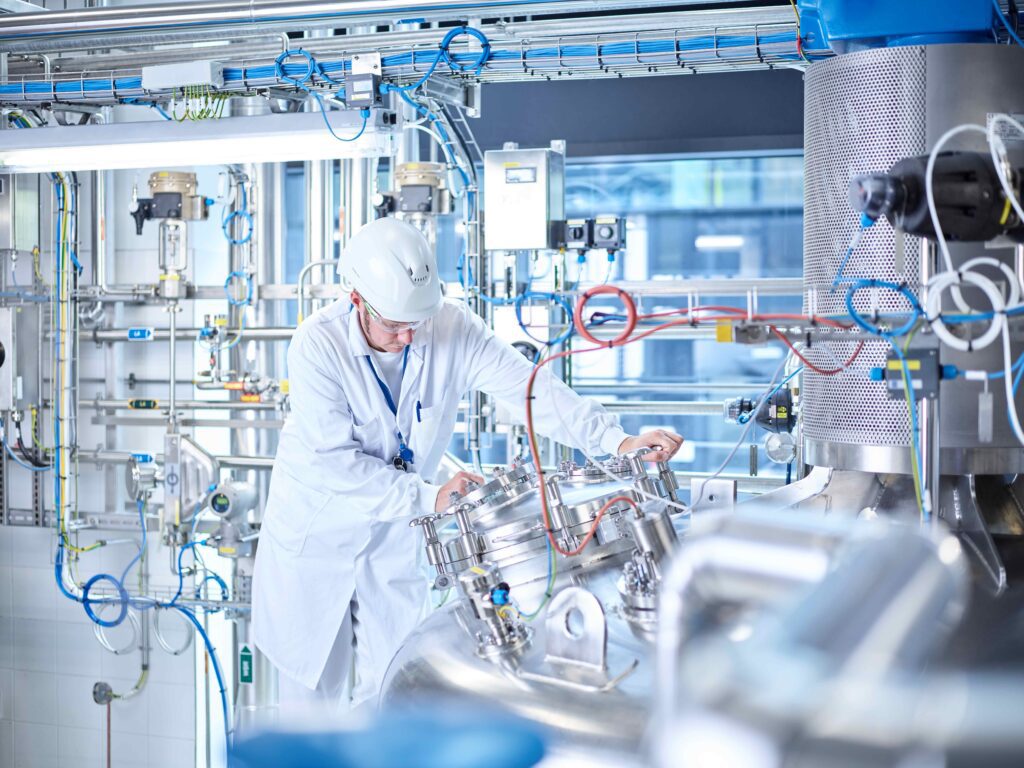According to the International Energy Agency (IEA), the chemical sector is the largest industrial energy consumer and the third largest industry subsector in terms of direct CO2 emissions. The IEA also marks the industry as “not on track” to meet the net zero emissions scenario and highlights the need to decouple CO2 emissions from chemical production by 2030.
The path to decarbonization in the chemical industry is through energy management, process optimization and asset management. Drive systems provide an effective mechanism to transfer kinetic energy to chemical processes. Such systems are at the heart of any sustainability measures.

Opportunities in the chemical industry
The chemical industry is diverse with energy-intense bulk chemical production at one end and raw material-intense specialty chemical production, at the other end. The common thread in producing these chemicals is the need to transfer kinetic energy to the material that is being processed.
Bulk chemical production like ethylene or ammonia involve large gas compressors where electrifying the drive with variable speed control can bring significant decarbonization and efficiency benefits. In polymers, variable speed drives for extruders can improve reliability, reduce maintenance, and improve the electrical system power factor. Similar benefits can be achieved for mixing or grinding equipment which form the core part of specialty chemical production.
Here are four sustainability enablers for these chemical processes.
Sustainability Enabler 1: Energy Management
Variable speed drives bring value to our clients through three energy management mechanisms:
- Energy monitoring (smart metering)
- Energy saving (optimized energy consumption)
- Low impact in the grid (low harmonics and active front end
Drives can be a source of accurate energy consumption data (typically about 95%). Operators can monitor and act on energy data through a local display or an automation system or a mobile device.
Drives natively contribute to energy saving via speed control (quadratic loads). Energy savings are higher for loads that vary based on plant operations. Larger energy savings are obtained when processes are run at lower flow and lower loads compared to nominal design. The plant operator consumes the right amount of energy for the process load to improve control, enhance efficiency, and extend equipment life.

Standard drive systems impact electrical networks due to their harmonics. Advanced drive systems include a three-level design that reduces motor stress, increases lifespan and no bearing currents. The result is enhanced power quality, improved EMC control and grid impact reduction with total harmonic distortion in current less than 5%.
Sustainability Enabler 2: Process Optimization
The second enabler comes from making operations decisions close to the process equipment to enhance process efficiency.
- Optimized operation of assets
- Decentralized application expertise
- Autonomous decision-making
Drive systems should include embedded equipment performance curves like pump curves. These will form the basis for performance monitoring, sensor-less estimation, and alarming using speed, flow, head, power, and efficiency relationships.
One example of decentralized application can be booster pump control. Such a system can have one drive for several motors without additional controllers. Operations strategy can be optimized across the booster pumps to reduce energy use and operate the pumps in-turns to decrease wear. Another example can be a multidrive system that provides flexible level control in the field for emptying or filling equipment. An optimal number and speed of pumps can be selected according to the estimated flow and monitor the system best efficiency point.
Multi-pump systems can have autonomous decision-making ability with redundancy and resilience to failures through several master architectures. Operation modes in such architectures can include distributed speed mode, synchronized speed mode, speed sharing mode, and include friction loss compensation.

Sustainability Enabler 3: Asset Management
The third enabler is the asset management capabilities that are built in to drive systems.
- Condition Based Maintenance
- Asset Protection Functions
- Smarter Maintenance
A condition-based maintenance system built into the drives will enable motor protection through thermal monitoring, current limitation, overvoltage, and real-time temperature monitoring. Another example is an anti-jam function with dual rotation mode that can use counted anti-jam sequences to protect the motor and prevent clogging.
Sensor-less or sensor-based protection functions can be embedded into drives for no flow or low flow, dry running, and inlet or outlet pressure protection. A pipe fill mode can be configured to prevent water hammer in pipe systems. Model specific settings can be configured for motor cyclic start protection against excessive restarts.
Modular design for LV and MV drives will allow simple parts replacement, minimizes spare parts stock, easy access, and reduced downtime. A dynamic QR code on the device can help easy troubleshooting through instant access to online tutorials, quick resolution, detailed error analysis, and proactive alerts
Sustainability Enabler 4: Connected Products
In today’s world, connectivity is critical, and this is especially true for drive systems.
- Comprehensive data – anytime anywhere
- Empowered operators
- Achilles Level 2 cybersecurity
Webserver with real-time drive data monitoring for processes and energy can provide insights for asset management and energy monitoring. Using this data, operator dashboards can be deployed to monitor the process. This enhances determinism of operations, boosts productivity, and easy data access.

An intelligent drive embeds cybersecurity to assess the network robustness of industrial devices and certify that they meet a comprehensive set of requirements. Such a design will enable security comparisons systems plus networks to meet current and emerging international cyber security standards (e.g., ISASP99) as well as government regulations (e.g., NERC/CIP).
Drive systems create a positive impact
Drive systems in chemicals should be ready for heavy industry use and designed for continuity of service with easy integration into automation systems. They need to run application functions which incorporate process expertise. In addition to these, today’s sustainability considerations demand enhanced energy efficiency, process efficiency as well as safe and reliable plant operations.
Learn more about how Schneider Electric can increase your efficiency through drive systems.

